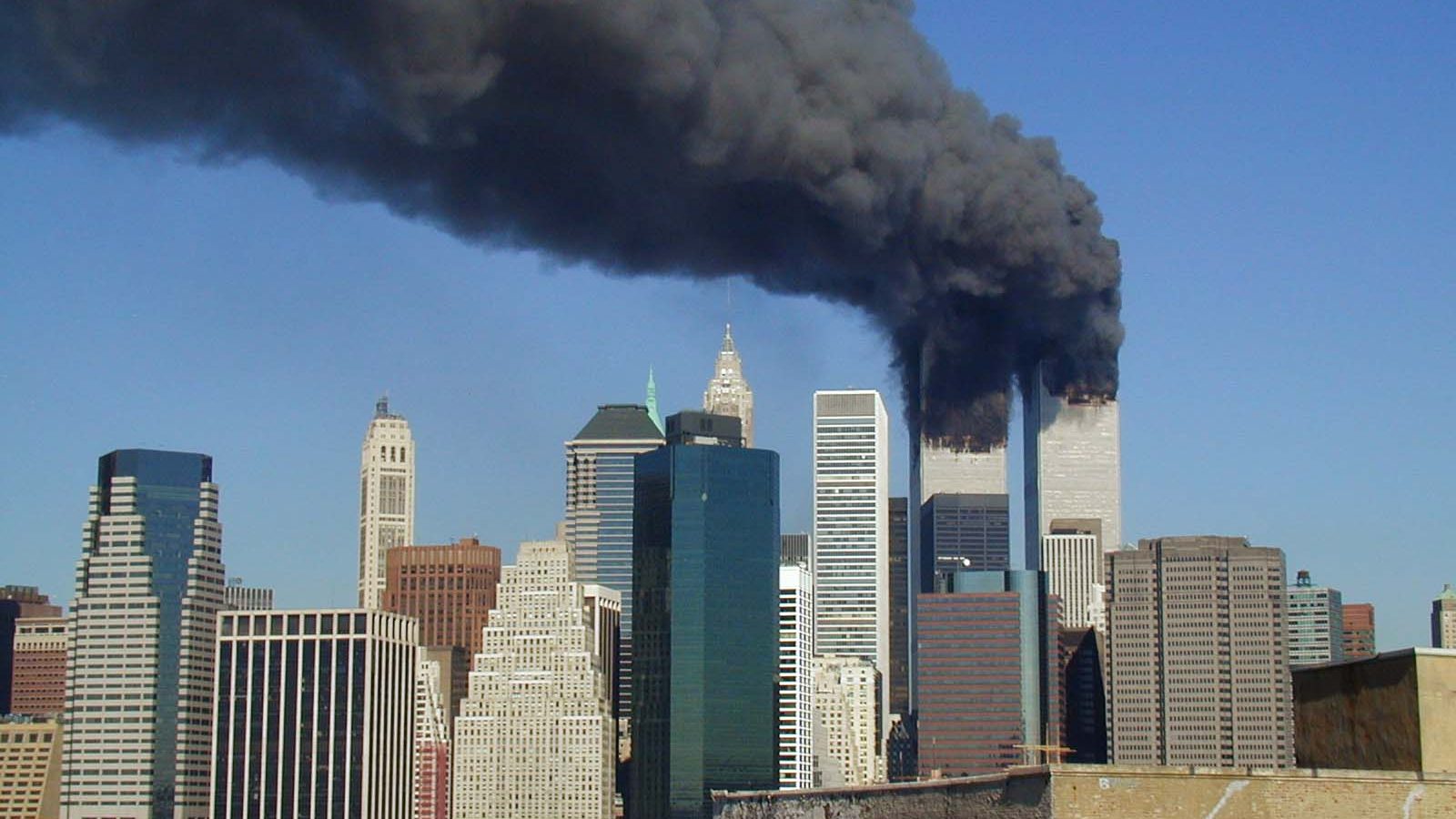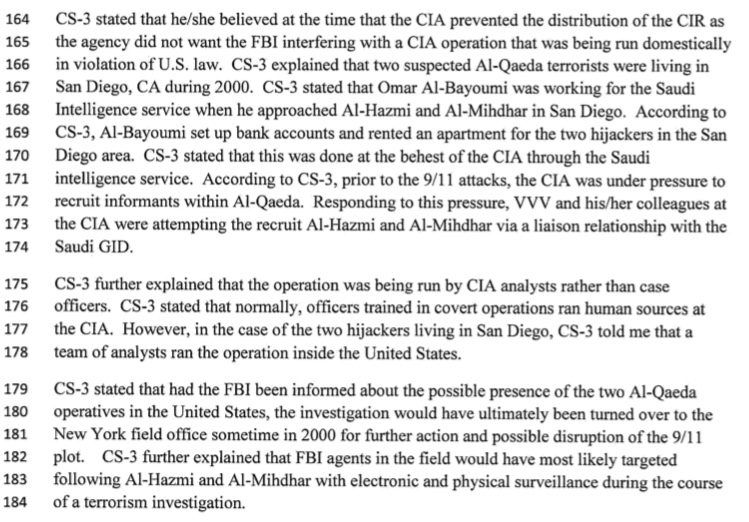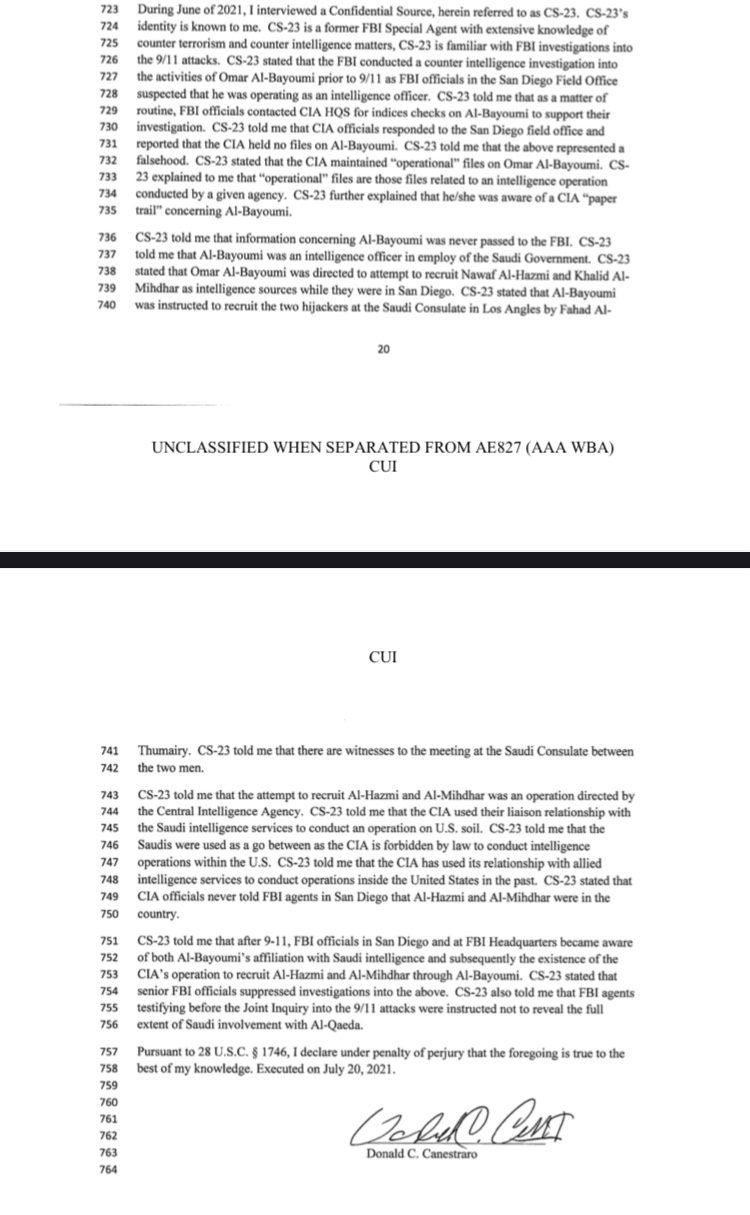A declassified court filing from the Guantanamo Military Commission, the court considering the cases of defendants accused of planning the 9/11 terrorist attacks in New York City, suggests that two of the hijackers were being closely monitored and possibly recruited by the Central Intelligence Agency (CIA) before the attacks on the World Trade Center.
According to reports, the court filing originally became public in July 2021 but was heavily redacted.
However, independent researchers reportedly obtained a “unexpurgated” copy that reveals further details of the declaration made by former DEA Special Agent Donald C. Canestraro.
From Florida Bulldog:
Canestraro said in a brief interview with Florida Bulldog that he is part of the defense team for Guantanamo detainee Ammar al-Baluchi, a Pakistani citizen who is awaiting trial with four other men accused of planning the 9/11 attacks. His declaration includes the results of his interviews with 11 ex-FBI agents, 2 ex-CIA agents, a CNN investigative journalist, former deputy National Security Advisor Richard Clarke and former Sen. Bob Graham (D-FL), co-chair of Congress’s Joint Inquiry into 9/11.
The 22-page declaration, first obtained by the national security website Spytalk, is not confidential, but rather it’s marked CUI – Controlled Unclassified Information. The Defense Counterintelligence and Security Agency defines CUI as “government created or owned information that requires safeguarding or dissemination controls consistent with applicable laws, regulations and government wide policies.”
“The document was originally published via a Guantanamo Bay court docket, but while public, it was completely redacted. Independent researchers obtained an unexpurgated copy. It is an account by the Commission’s lead investigator, DEA veteran Don Canestraro, of his personal probe of potential Saudi government involvement in the 9/11 attacks, conducted at the request of the defendants’ lawyers,” RT reports.
RT provided further background on the two men allegedly being monitored and possibly recruited by the CIA:
Of the great many enduring mysteries of the 9/11 attacks still unresolved over two decades later, perhaps the biggest and gravest relate to the activities of Nawaf al-Hazmi and Khalid al-Mihdhar in the 18 months leading up to that fateful day. The pair traveled to the US on multi-entry visas in January 2000, despite having repeatedly been flagged by the CIA and NSA previously as likely Al Qaeda terrorists.
Mere days before their arrival, they attended an Al Qaeda summit in Kuala Lumpur, during which key details of the 9/11 attacks are likely to have been discussed and agreed. The meeting was secretly photographed and videotaped by Malaysian authorities at the direct request of the CIA’s Alec Station, a special unit set up to track Osama bin Laden, although oddly, no audio was captured.
Still, this background should’ve been sufficient to prevent Hazmi and Midhar from entering the US – or at least enough for the FBI to be informed of their presence in the country. As it was, they were admitted for a six-month period at Los Angeles International airport without incident, and Bureau representatives within Alec Station were blocked from sharing this information with their superiors by the CIA.
“We’ve got to tell the Bureau about this. These guys clearly are bad. One of them, at least, has a multiple-entry visa to the US. We’ve got to tell the FBI,” Mark Rossini, a member of Alec Station, has recalled discussing with his colleagues. “[But the CIA] said to me, ‘No, it’s not the FBI’s case, not the FBI’s jurisdiction.’”
The court filing suggests that the CIA obstructed official 9/11 investigations to conceal its infiltration of Al-Qaeda.
“During August of 2016, I interviewed a former FBI Special Agent whose identity is known to me. The former agent is herein referred to as CS-3,” Canestraro stated in the filing’s declaration.
“CS-3 stated that had the FBI been informed about the possible presence of the two Al-Qaeda operatives in the United States, the investigation would have ultimately been turned over to the New York field office sometime in 2000 for further action and possible disruption of the 9/11 plot,” the declaration added.
From the court filing:
The declaration later stated: “information was not passed to the FBI as the CIA was running a ‘long term intelligence operation’ to penetrate Al-Qaeda.”
An investigation determined that no information was sent by the CIA to the FBI regarding the hijackers’ multiple entry visas into the United States.
CS-23, referred to in the filing as a former FBI Special Agent with extensive knowledge of counter terrorism and counter intelligence matters, said that “the attempt to recruit Al-Hazmi and Al-Mihdhar was an operation directed by the Central Intelligence Agency.”
“CS-23 told me that the CIA used their relationship with the Saudi intelligence services to conduct an operation on U.S. soil,” the declaration added.
“CS-23 told me that the Saudis were used as a go between as the CIA is forbidden by law to conduct intelligence operations within the U.S.”
Read more below:
Cont. from RT:
This account was backed up by another FBI investigator, ‘CS-3,’ who further claims that Bayoumi setting up bank accounts and renting an apartment for the two hijackers in San Diego “was done at the behest of the CIA.” Any information provided to Bayoumi would then be fed back to Alec Station.
CS-3 felt it odd that this CIA unit, situated in the US and staffed by analysts, was involved in recruiting Al Qaeda operatives, as such work is typically the responsibility of case officers trained in covert operations based overseas. ‘CS-IO’ concurred that this arrangement was “highly unusual,” and made it “nearly impossible for [Alec] Station to develop informants inside of Al Qaeda from its base several thousand miles from the countries where Al Qaeda was suspected of operating.”
Despite such tantalizing leads, CS-23 claims senior FBI officials suppressed further investigations into the CIA’s relationship with Bayoumi and the recruitment of Hazmi and Midhar, and Bureau representatives testifying before the joint Senate and Congressional inquiry into 9/11 were instructed not to reveal the full extent of Saudi involvement with Al-Qaeda.
For their part, CS-3 stated that before they and their colleagues were interviewed by the joint inquiry, CIA officials within Alec Station told them not to cooperate fully with investigators and they were looking to “hang someone” for 9/11.
Canestraro does not make any conclusions as to why the CIA concealed vital information from the FBI prior to the attacks, which potentially could have prevented their execution, and why the Bureau subsequently played along with the Agency’s coverup. Although one answer is provided by the unusual nature of Alec Station’s setup.
Namely, that far from infiltrating an Al Qaeda cell to avert terrorism, the Agency was seeking to influence and direct its activities in order to cause terrorism, outside standard recruitment channels. Having stumbled upon such a monstrous connivance, the FBI would’ve known well to leave the entire subject well alone.
Florida Bulldog noted:
While most criticism in the declaration is directed at the CIA, higher ups at the FBI were also targets of the FBI agents’ complaints.
An ex-agent in the bureau’s Washington Field Office referred to as CS-9, was part of a squad tasked with investigating leads developed after the attacks. CS-9 told Canestraro that “agents were told they were not permitted to interview Saudi nationals in support of their investigation. CS-9 stated that many of the leads developed during his/her investigation pointed toward the Saudi diplomats stationed in Washington, D.C.
Another former FBI agent, CS-4, who in the spring of 2002 supervised two other FBI agents assigned to the CIA’s UBL Station, stated that “CS-3 approached him/her and said, ‘Boss, something is bothering me big time…we [meaning the United States government] could have prevented the 9/11 attacks.” CS-3 then outlined the CIA intelligence that showed Hazmi and Mihdhar had attended the Malaysian al Qaeda meeting, that the CIA knew in January 2001 that both men had multiple entry visas to the U.S. and that his FBI colleague had written a report on the future hijackers that “was not distributed on orders from one of the analysts at UBL Station.”
CS-3 gave his supervisor a draft of the report. The supervisor, a male, asked who else knew about it. CS-3 said just him and the colleague who wrote it. The supervisor said he then contacted FBI deputy director for counterterrorism Pasquale D’Amuro saying he needed to meet right away. The supervisor hopped in his car and “at a high rate of speed” drove to FBI headquarters where he met with D’Amuro and gave him the secret UBL report on Hazmi and Mihdhar.
“D’Amuro read the cable then told CS-4, ‘I will take care of this,’ the declaration says. “CS-4 noted that D’Amuro never mentioned the cable’s existence” again.
A short time later, though, CS-4 was promoted out of UBL Station to a senior liaison position outside of the FBI. He hadn’t asked for a promotion and told Canestraro he felt he was moved away from UBL Station because he “knew about the existence” of the CIA’s secret report on Hazmi and Mihdhar. CS-4 added he believed he was moved to ensure he “kept silent.”
Read the full declaration by Donald C. Canestraro HERE.







Join the conversation!
Please share your thoughts about this article below. We value your opinions, and would love to see you add to the discussion!